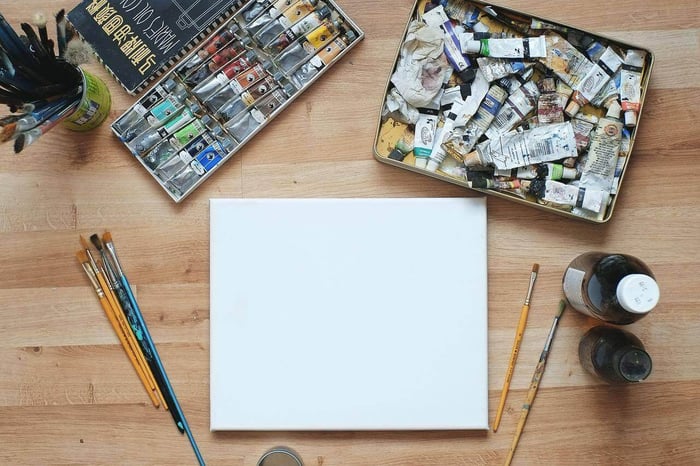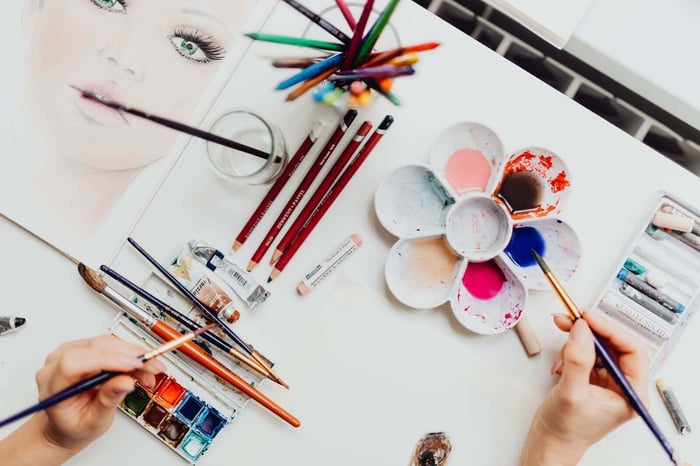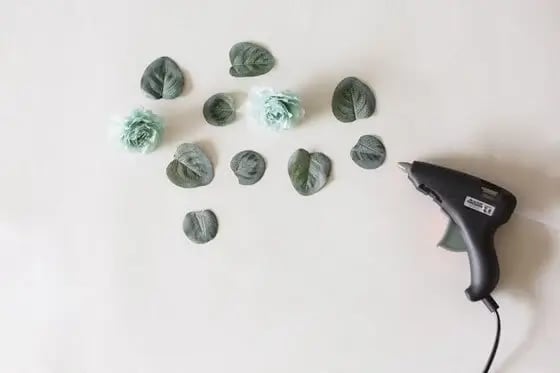Creating an art portfolio is one of the most important steps when applying for art school or a job in the industry. It isn't just about showing off all your favourite artworks in an art folder either, an art portfolio should be specially curated and well-thought out. That’s why it’s crucial to take your time to get it right.
So where do you get started? We’ve outlined our best tips and tricks on how to create an art portfolio, along with some portfolio inspiration so you can stand out from the crowd!
Overview:
- What is an art portfolio?
- What should an art portfolio include?
- How to create an art portfolio
- Learn the art portfolio requirements
- Gather art portfolio inspiration
- Plan your art portfolio
- Create new or improve existing artworks
- Select your final pieces
- Curate the layout of your portfolio
What is an art portfolio?
An art portfolio is a thoughtfully curated collection and presentation of artworks that show off your development, creativity, skills and interests. Every art school or workplace will have different requirements and expectations that applicants must follow.
But, finding the best way to present your artworks and deciding what mediums to use can be very challenging for many artists. There is no one set way to create an art school portfolio, the best thing you can do is learn the criteria and give yourself plenty of time to test different mediums and portfolio layouts.
How many pieces of art should be in a portfolio?
It all depends on the requirements of the art school or workplace you’re applying to. An art portfolio generally consists of 10 to 20 pieces of your best and most recent artworks. But, keep in mind it’s better to submit 10 of your most creative artworks, rather than 20 with some that are average or repetitive.
What should an art portfolio include?
This will change depending on where you’re applying. But, generally art portfolios will include the following:
- Cover letter: This is an important document to include as it will introduce yourself and your artworks to the viewer. Your artist cover letter should be short, sharp and sweet!
- Artist statement: This is a brief statement that should be written in the first person. It should outline the meaning behind your works, your process and why you choose to create your artworks.
- Artist biography: This is a formal statement that should be written in the third person. It should include your artist background, where you learnt your skills and any exhibitions you have been involved in.
- Resume: This will be the same layout as a typical resume, however, it should focus on your artist experience, awards and exhibitions.
- Finished artworks: these should showcase strong drawing skills in your mediums and include a range of subject matter.
- Working documents: these are important to show off your process.
What should you avoid in an art portfolio?
There are a number of common mistakes that artists tend to make when submitting portfolios. Here are some you can avoid:
- Cliche artworks
- Copying directly from a photo
- Low quality photos to document the process
- Blank backgrounds
- Placing the subject straight in the centre
- Not getting your portfolio reviewed for feedback
- Including too many unfinished pieces
How to create an art portfolio
1. Learn the art portfolio requirements
Whether you’re applying for art school, university or a job in the creative industry, there will always be a set of requirements that you will need to follow. For example, these may include:
- A portfolio due date
- Specific size and formatting
- Finished works only
- Original copies or hard copies (if the portfolio is online)
- Presentation and labelling
- An artist statement, resume or written essay
Please note: criteria may differ for international and domestic applicants. If you are applying for an art school, we also advise that you note down the open day times to find out more about the expectations and criteria.
2. Gather art portfolio inspiration
Looking at successful art portfolio examples is one of the best ways to get an idea of what you can do. Some universities and workplaces will include portfolio examples on their websites, however, if you are having trouble finding inspiration, we have included some below.
M.C Goodwin (online art portfolio)

For more inspiration, view M.C Goodwin’s portfolio website.
Tatiana Florival

For more inspiration, view Tatiana Florival’s website.
Cecelia Cao
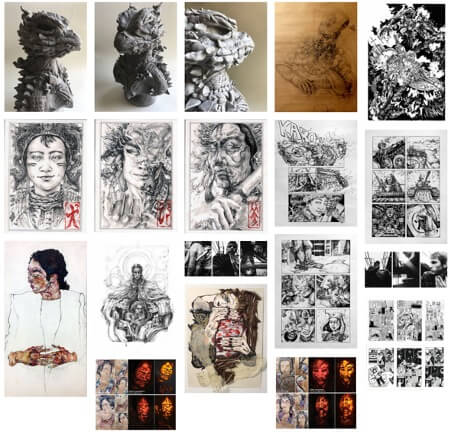
For more inspiration, view Cecelia Cao’s artworks.
Jordan Mc-Cracken-Foster

For more inspiration, view Jordan Mc-Cracken-Foster’s artworks.
Lauryn Welch
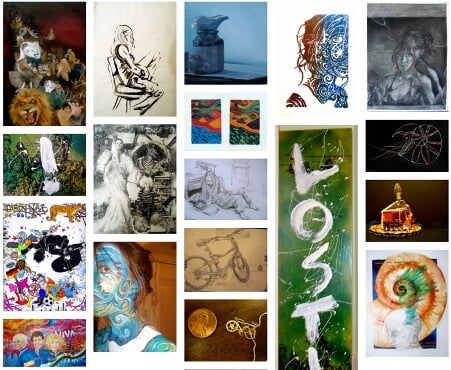
For more inspiration, view Lauryn Welch’s website.
3. Plan your art portfolio
This is the hardest part of the portfolio process where you need to decide on the types of work you will include. We recommend choosing a range of recent artworks that showcase your skills, interests and originality.
Generally you should be planning to include artworks that:
- Showcase your observational drawing and technical skills.
- Explore different subject matter, such as landscapes, portraits and the human figure.
- Use a range of mediums, such as artist paint, art pencils, air dry clay, markers and more.
- Experiment with a range of tools and techniques, including drawing, paintings, photography and model making
- Include well balanced compositions, where all elements are visually pleasing to the eye
- Document your art process. This could include photographs or small sketches of how you progressed to the final product
- Interest you and show the audience your personality
You should also consider the surfaces you use to create your artworks. You can use painting papers, canvas, sketch pads, visual diaries and plenty more.
4. Create new or improve existing artworks
Once you have planned what you would like to include in your portfolio, you will need time to improve existing artworks and create new ones. The time length can be different for everyone, but we advise giving yourself around 6 months to experiment with new artistic techniques and mediums. If you have a time constraint, quality work can be very hard to produce.
If your art portfolio requires 10 artworks, challenge yourself and create 25 or more pieces of art. This way you can carefully select the 10 pieces you feel best fit your portfolio!
5. Select your final pieces
For each project, select only the artworks that have a unique approach. For example, you could select paintings that wouldn’t be easily achievable with drawing materials, or choose drawings that can’t be easily produced with a camera. That’s why experimenting with different mediums is essential to showcase your strengths and artistic capabilities.
6. Curate the layout of your portfolio
Curating the presentation of your portfolio is important. The way you choose to organise your works will affect the way your work is perceived. Instead of just putting all your favourite artworks together, carefully organise the best ones that will leave a lasting impression. Carefully curate your artworks in an order that makes sense to you and that is easy to navigate. And don’t forget to receive feedback from another artist.
When organising your portfolio presentation you should:
- Choose a neutral coloured art folder
- Order your artworks in a chronological and visually pleasing manner. You could group artworks by medium, subject or style
- Avoid repeating similar ideas
- Make sure works are clean and secured in the sleeves
- Use clear labels
Create your portfolio with quality supplies from Art to Art
Now that you know how to create an art portfolio, it’s time to experiment with a range of art supplies from Art to Art. We stock everything, from mediums and paint brushes to paper and more! Shop online today and get fast same day dispatch. Plus, you can also buy now and pay later with Afterpay. If you have any questions about student portfolios, please don’t hesitate to contact us today.
People also read:
- Watercolour pencils vs paint
- Different types of canvas
- Best gifts for art students




